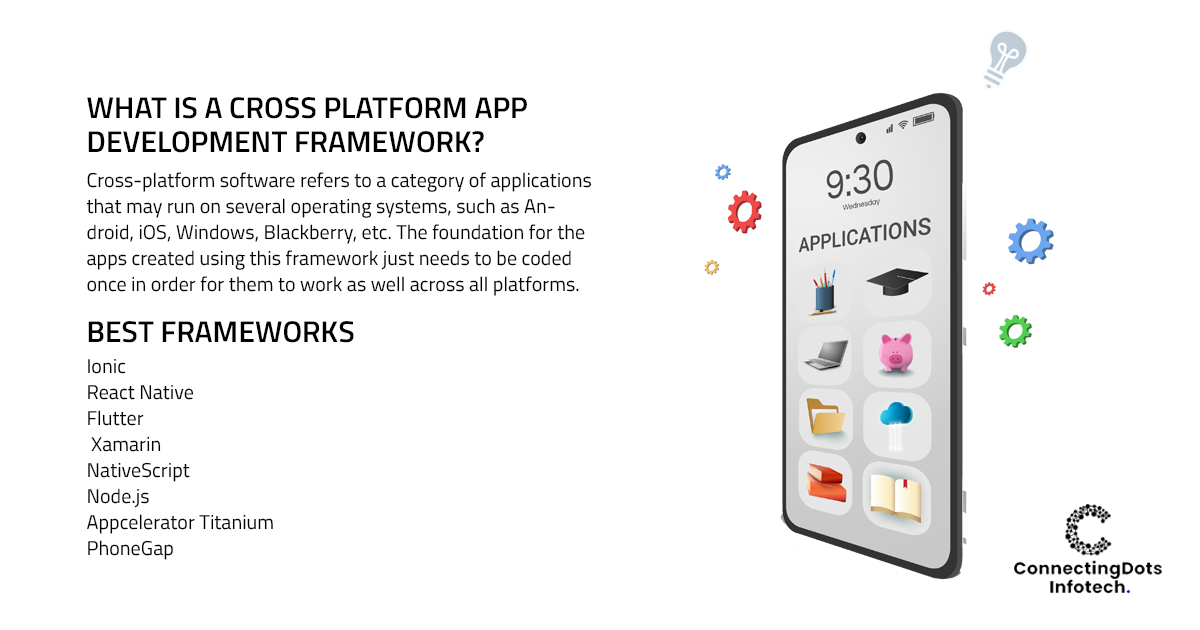Top Cross Platform App Development Frameworks

Cross-platform app development has many benefits, which greatly contribute to its current popularity. A variety of cross-platform application development frameworks and tools started to surface on the market as it expanded, initially gradually and then all at once, as every other developing mobile applications company tried its hand at this distinctive and exciting technology.
What is a Cross Platform App Development Framework?
Cross-platform software refers to a category of applications that may run on several operating systems, such as Android, iOS, Windows, Blackberry, etc. The foundation for the apps created using this framework just needs to be coded once in order for them to work as well across all platforms. It is one of the most favoured methods in the app development market today because virtually all of the major application development service providers recommend it.

Best Frameworks
1. Ionic
Ionic, which is based on AngularJS, is one of the best and most popular cross-platform application frameworks. It gives programmers access to native system drivers by fusing the Cordova wrapper with popular programming languages like HTML5, JavaScript, and CSS.
With Ionic, app developers may create a fantastically imaginative user interface and include user-friendly features. Ionic is the best framework for PWA design because the apps developed with it are incredibly dynamic and native-like.
2. React Native
It is difficult to talk about cross-platform application frameworks without mentioning React Native. It is a JavaScript framework that is used to write actual code and provides a native-like experience for mobile applications that run on both Android and iOS. React Native is the preferred platform for businesses and developers to employ for their projects because of its excellent capabilities.
React Native gives developers the opportunity to write modules in Objective-C, Swift, or Java while combining the benefits of JavaScript and React.JS. Additionally, developers can do time-consuming processes like image editing, video processing, and other activities that are not handled by the framework APIs by utilising native modules and libraries in cross-platform React Native projects.
3. Flutter
The impressive Flutter cross-platform application framework was unveiled by Google in 2017. The software development kit was developed to speed up the creation of Android and iOS apps. This is an essential and significant method for producing Google Fuschia apps.
Flutter offers applications that run swiftly, effectively, consistently, and dynamically across a range of platforms.
4. Xamarin
In comparison to the previous frameworks we have studied, Xamarin's cross-platform app development frameworks are very different. Using C# and .NET instead of JS libraries and HTML, it is a simplified framework that enables developers to create applications for Android, Windows, and iOS. 90% of the code can be used by programmers to create an app for three different platforms.
Making the decision between Xamarin and React Native significantly more challenging is the ability of Xamarin to produce applications that look and feel like native apps thanks to its outstanding APIs.
5. NativeScript
NativeScript is a terrific free cross-platform framework that is based on JavaScript. It wouldn't be inappropriate to recommend NativeScript to developers looking for WORA functionality.
Programmers also have the choice of integrating pre-existing plugins directly from NPM because NativeScript has access to all native APIs.
6. Node.js
An excellent tool for building cross-platform programs is the Node.js framework. A JavaScript runtime framework built on top of the Chrome V8 JavaScript engine is what Node.Js essentially is. The environment is open-source, which promotes the development of scalable server-side networking programs. The speed and responsiveness of cross-platform Node.js programs are intrinsic.
The framework has the ability to control numerous connections at once. It also features a sizable library of JavaScript modules, which facilitates the creation of online applications.
7. Appcelerator Titanium
Appcelerator is one of numerous cross-platform application development solutions designed to make mobile application development easier and more productive. It is an excellent method for creating cross-platform apps from a single code base. Its major objective is to speed up the creation of apps using native components contained in JavaScript language.
8. PhoneGap
Employing CSS, JavaScript, and HTML5, Phone Gap (Cordova) is a great cross-platform framework for developing mobile applications. Additionally, it offers developers a cloud-based alternative that allows them to share their app while it is still in development in order to get feedback from other developers.
It utilises current web technologies to produce beautiful apps. Another remarkable advantage is that PhoneGap completely supports built-in device features like GPS, Storage, Camera, Phonebook, and others.
9. Sencha Touch
Sencha Touch is a tool for building cross-platform web applications that effectively utilise hardware acceleration techniques, and it was first made available roughly ten years ago. Using Sencha Touch, developers may create extensively researched, securely integrated UI components and frameworks. In fact, it's easy and efficient to design and maintain large business programs.
10. Corona SDK
Developers may produce 2D mobile apps for all the leading operating systems, like Windows and the Kindle, with the Corona SDK.
Mobile and game app development are 10X faster. The framework's reliance on the portable, multi-paradigm programming language Lua enables it to deliver excellent results. The language's main design considerations during development included speed, scalability, portability, flexibility, and ease of use.
It also allows real-time testing, is a free framework, and works with both Mac OS X and Windows.
Conclusion
After considering all of the main picks that a competent cross-platform application development organisation is searching for in this market, there is nothing left to do but wait and observe how these frameworks fare against each other in the highly competitive market as well as how they charge against the new frameworks that are presently entering the market.
